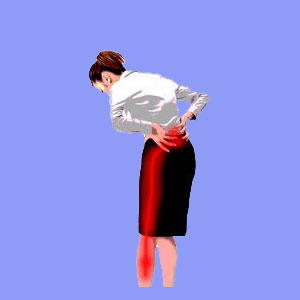
A sciatica attack is a dreaded recurrent event consisting of back and leg pain which may begin suddenly and sometimes without any provocation at all. Many people suffer acute sciatica episodes based on expected activity-related occurrences, while others are held captive by fear, never knowing when an attack might take place or what circumstances might create the pain.
This dialog will cover acute attacks of sciatica, typically known as flare-ups. We will examine the possible reasons why sciatica might strike suddenly and how patients may be able to become more proactive in preventing these agonizing episodes of suffering.
Causes of Sciatica Attacks
Acute sciatic conditions occur when symptoms come on fast and severe. Some attacks take place when the person aggravates an existing radiculopathy condition through some movement or injury. Bending and lifting are known reasons why many people endure sudden instances of sharp pain. However, almost any physical activity can be theorized to cause or aggravate sciatica, including sitting, standing or exercise.
However, sciatic nerve pain can also be exacerbated by an emotional instigator. Ischemia is definitely the most prevalent source of mindbody sciatica symptoms and is usually the direct result of a psychosomatic process, not a physical or structural problem. In these instances, repressed emotional issues might bring on symptoms in times of stress, in order to maintain the anonymity of psychological sensitivities.
Sciatica First Aid
If you experience sharp pain which is debilitating, there is little which can be done to immediately end the attack. Finding relief from such agonizing symptoms is difficult, but there are some guidelines which can help to resolve the attack quickly:
Do not get stressed out by the pain. Emotional stress might be the reason why the pain exists to begin with and will certainly make any purely physically-induced symptomatic complaint far worse and longer lived.
Do not confine yourself to bed. Get some rest, but try to move around carefully to keep the circulation going to the affected area.
Do not depend too heavily on prescription sciatica drugs. These pharmaceutical products are dangerous and can cause a wide range of health concerns. They will not do anything to speed the healing anyway.
If the pain does not go away in a few weeks, or gets much worse, make sure to visit your physician for a complete exam.
Sciatica Attack Guidance
Chronic sciatica, or recurrent bouts of acute pain, might be indicators of a mistaken diagnosis. This is far more common than most patients could possibly imagine and is the same reason why I suffered for decades from terrible lower back pain and sciatica.
There is an explanation for why your pain will not get better and a reason why it returns to haunt you time and time again. It is crucial to discover the actual source of your pain, if you are to have any hope of defeating it once and for all.
Patients with these unresolved pain events are advised to investigate appropriate treatment options. If you have already tried everything, but have not found lasting relief, then this may also indicate a mistaken diagnosis.
Statistically, physically-motivated pain syndromes should resolve with appropriate care. If this does not occur, then it is possible that all the therapies are actually being directed against a coincidental spinal abnormality, rather than the true symptomatic source.
If you suspect an emotional cause or contributor to your recurrent attacks, then it may be wise to investigate knowledge therapy. This approach is completely free and does not demonstrate any risks, making it unique in the sciatica treatment sector.
In summation, if you are one of the patients who only has attacks after certain activities or positions, then consult with your physical therapist or neurologist. They may be able to determine why particular circumstances enact painful symptoms and might also be able to suggest ways of preventing these flareups from ruining any more of your future enjoyment of life.





